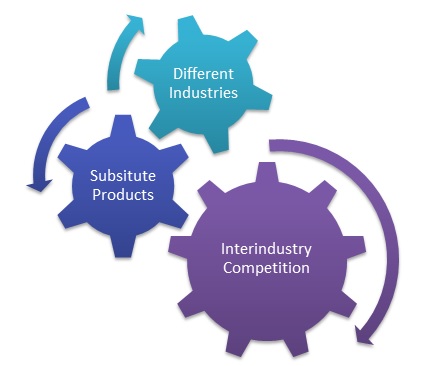- Business Concepts ›
- Marketing and Strategy ›
- Interindustry Competition
Interindustry Competition
Definition, Importance & Example
This article covers meaning & overview of Interindustry Competition from marketing perspective.
What is meant by Interindustry Competition?
Interindustry competition is a type of rivalry which emerges between companies and businesses operating in different industries. Interindustry competition arises as competitive pressures drive market players to cross the boundaries of a fixed industry in order to achieve competitive advantage. Such interindustry competition among sellers in different industries arises in order to achieve such objectives as acquiring a larger share of a market, increasing sales and increasing profits, by encouraging consumers to substitute to a seller's products and services.
For instance, the competition between an aerospace company and an automobile company for a government manufacturing contract for a military system.

Importance of Interindustry Competition
1. The reactor's awareness of opportunities and competitive interdependence influences the extent of competitive interaction among the firms.
2. Awareness along with factors like the firm's organisational structure has an effect on the firm's information processing capabilities. The more formal and complex the organisational structure is, the more delayed is the information processing and biased information dissemination.
3. Resource similarity also has an effect on awareness. a firm can easily access and understand the consequences of an attack by a rival with more similar resources. Usually, resource similarity is less in case of Interindustry competition.
4. Other awareness drivers are the competitor's reputation and its past competitive behaviour.
5. The motivation to react to any competitive action depends on the future consequences or outcome of that action of the firm.
6. Firms with a higher degree of market dependence will fight vigorously for their firm's position. Again, if market commonality will be high, and firms meet in several markets, the likelihood of attack will be lower but there will be high retaliation.
7. The capability to act depends on factors like the organisational size (influencing its ability to influence market environment and competitors) and organisational slack (in terms of resources which gives the firm managerial flexibility to respond to environmental and competitive changes).
8. More complex and bureaucratic organisations will take more time for decision making and action implementation which has a detrimental effect on their capability.
Read More
Difference between Interindustry and Intraindustry Competition
While Interindustry competition arises by the rivalry between businesses and firms operating in different industries, Intraindustry competition is the competition between firms within the same industry. A firm dealing with cotton clothes competing with firm manufacturing synthetic fabrics is an instance of Intraindustry competition. In contrast, an Interindustry competition can be seen in some industries where primary metal used is Aluminium has to compete with copper since copper can be substituted in applications like Electric devices, robots, machinery.
Examples of Interindustry Competition
1. IT companies like Amazon and Mobile operators belong to a different industry than traditional banks, but now these IT companies and mobile operators because of their additional services and ease, pose serious competition to the traditional banks.
2. Another example of Interindustry competition is the declining revenues of voice calls for mobile operators due to the competition posed by social media and enabling technologies like Wi-Fi.
Hence, this concludes the definition of Interindustry Competition along with its overview.
This article has been researched & authored by the Business Concepts Team which comprises of MBA students, management professionals, and industry experts. It has been reviewed & published by the MBA Skool Team. The content on MBA Skool has been created for educational & academic purpose only.
Browse the definition and meaning of more similar terms. The Management Dictionary covers over 1800 business concepts from 5 categories.
Continue Reading:
What is MBA Skool?About Us
MBA Skool is a Knowledge Resource for Management Students, Aspirants & Professionals.
Business Courses
Quizzes & Skills
Quizzes test your expertise in business and Skill tests evaluate your management traits
Related Content
All Business Sections
Write for Us